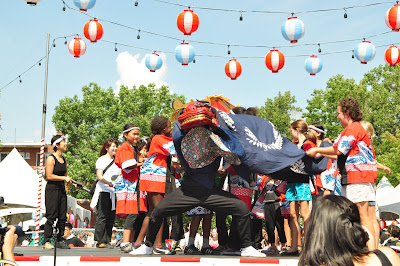Whoosh! Christmas rather caught me by surprise this year. Maybe it's the lack of snow, but it took me longer than usual to get into the spirit of things. And yet, with just a few hours to go till Christmas Eve officially starts, everything seems to be on track: the tree is trimmed, the gifts are wrapped, and I've got bread baking in the oven.
As usual when we stay in Montreal, we're spending Christmas Eve with Laurent's parents. They always invite quite a crowd over, and there's always a mountain of food, prepared by Laurent's father. This year, however, I wanted to contribute in some way. I thought about something I can make that no one else around me does; and it had to be something appropriate for an Italian Christmas, so Asian food was out. So I settled on bread. Bread isn't an essential part of supper, but I find homemade bread always adds a nice touch.
So I spent part of today making two kinds of bread from my favourite Marcy Goldman book: pull-apart buttery rolls, which I have made before, and buttermilk biscuits. They're almost ready, so perhaps I'll snap a picture and add it to the end of this post.
I haven't done much holiday baking this year. I did make gingerbread men, for the very first time, and am quite pleased with the flavour, although I may have overbaked them a bit. And I made lard cookies.

I'm quite into Jennifer McLagan's cookbooks at the moment. As you may know, she's been specializing in unpopular foods for several years: Bones (or rather, cooking on the bone), Fat, and, most recently, Odd Bits (not just offal, but generally all the parts of the animal people tend to not use anymore). While flipping through Fat, I came upon a recipe for Spanish-style lard cookies, and decided to give it a try. I'd never cooked with lard before, and was even very surprised to discover how available it is, found in the pastry aisle at most supermarkets - too bad, I was already having visions of rendering pork fat.
The cookies were as simple to make as cookies can be. I substituted orange liqueur for brandy, as I don't keep the latter in the house. Honestly, I'd be prepared to be that no one, save an expert baker, would ever guess that these cookies were lard-based: you can't taste it at all. But it apparently gives a unique texture, and while I would have to make a butter version to compare and really determine the difference, I'd describe the ones I made as crispy, but not brittle or hard, and not sandy either. Not sure this description is very useful, but I would definitely make these again.

Oooh, look at that, my bread is ready! The biscuits taste good, but to be honest they're rather unattractive. Oh well. The pull-apart rolls, on the other hand, look fabulous. (Sorry for the saturated pics, I'm in a hurry.)

Merry Christmas and Happy Holidays to everyone!
Orange-flavoured Lard Cookies
Slightly adapted from Jennifer McLagan's Fat
Yields around 20 cookies
125g (4.2 oz, 6/8 cup) all-purpose flour
60g (2 oz, 1/2 cup) almond flour
100g (3.5 oz 1/2 cup) granulated sugar
2 tsp ground cinnamon
Pinch of salt
100g (1/2 cup, 3.5 oz) lard, diced, at room temperature
1 whole egg
Zest of one orange, finely grated
1 tbsp orange liqueur (Cointreau or Triple Sec)
Icing sugar, for dusting
Preheat oven to 180ºC (350ºF). Line baking sheets with parchment paper.
Mix the flour and almond flour together in a mixing bowl, then spread them on a baking sheet in an even layer. Roast them in the over, stirring occasionally, until they are fragrant and just beginning to brown. Remove from the oven and let cool completely.
Lower the oven to 150ºF (300ºF).
Put the cooled flour and almond mixture in a large mixing bowl, stir in the sugar, cinnamon, and salt. Add the lard and work it into the flour mixture with a wooden spoon or dough whisk, to obtain a homogenous mixture.
In a smaller bowl, whisk together the egg, orange zest, and liqueur. Incorporate this mixture into the flour and lard mixture, and stir to obtain a soft dough.
Take tablespoonfuls of dough, form them into balls, and place them on the prepared baking sheets, about 4 cm (1 1/2 inches) apart, and slightly flatten them with the palm of your hand. Bake until firm to the tough and slightly browned on the bottom, about 30 minutes.
Transfer the cookies to a wire rack and cool completely. Dust with icing sugar and store in an airtight container for up to one week.















































